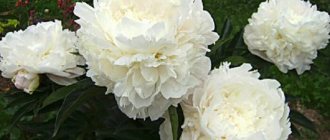Author: Elena N. https://floristics.info/ru/index.php?option=com_contact&view=contact&id=19 Category: Garden plants Published: February 07, 2019Last edits: November 03, 2020
- How to care
- Dividing the bush
- Shelter of a tree peony for the winter
The tree peony is a long-lived plant: it lives on average for a century or a century and a half, but in Asia there are specimens that are half a thousand years old. For the Chinese, the peony flower is a symbol of the awakening of life. Unfortunately, flowering does not last very long, but if you plant several plants with different flowering periods on the site, this period can be significantly increased. The tree peony is cold-resistant, but even if it happens to freeze in winter, the plant quickly recovers in the spring. From our article you can find out:
- what is the difference between a tree peony and a herbaceous one?
- how and when is the best time to plant a peony;
- how to care for the plant and how to prepare it for wintering.
Planting and caring for tree peonies
- Planting: from mid-August to late September.
- Flowering: April-May.
- Lighting: bright sunlight, light partial shade.
- Soil: fertile loam.
- Watering: twice a month, 6-7 liters of water for each bush, in extreme heat - more frequent watering; from August, watering is gradually stopped.
- Fertilizing: at the beginning of the growing season - with nitrogen fertilizer, during the budding period - with potassium-phosphorus fertilizer, during the flowering period - with a full complex.
- Pruning: annually in spring.
- Reproduction: by dividing the bush, cuttings, layering, grafting.
- Pests: aphids, caterpillars.
- Diseases: gray rot, brown spot, root rot.
Read more about growing tree peonies below.
Tree peony flower , or subshrub, is a species of hybrid plants of the genus Peony of the Peony family. Some scientists argue that this is not even a species, but simply a group of varieties and forms of hybrid origin, of which there are more than five hundred in the world today, and most of them grow in China. The tree peony flower is the product of Chinese breeders, although Japanese flower growers enthusiastically began cultivating this plant as soon as it appeared on the territory of their islands during the Tang Dynasty. Tree peonies were brought to Europe at the end of the 18th century and received absolute recognition from both professional flower growers and flower lovers.
Recommendations and common mistakes
When growing crops, gardeners often make mistakes that ultimately have a negative impact on the development and flowering of the shrub, even with good care:
- Planting too early or late. Tree peony cannot be transferred into the ground until the return frosts pass in the spring or just before the coldest weather in the fall. In both cases, the bush may not take root.
- Excessive watering. The tree peony loves moisture, but in swampy soil it gets sick and dies. If there is natural precipitation, the shrub does not need to be watered. During periods of drought, when caring for the plant, moisten it abundantly, but not too often.
- Thickening. In an attempt to grow lush bushes, gardeners often neglect to trim side branches. However, this has a rather negative effect on flowering. The plant spends a lot of resources maintaining green mass and ultimately produces fewer buds.
After planting, during the care process, it is recommended to observe moderation when applying fertilizing. Excessive amounts of useful substances in the soil, especially nitrogen, lead to deterioration of flowering and slower growth of shrubs.
Botanical description
The plant is a deciduous shrub, reaching a height of one and a half or two meters. Stems are light brown, thick, erect. They do not die off every autumn, like the stems of the herbaceous peony, but grow every year, gradually turning the plant into a hemispherical bush. The leaves of the tree peony are openwork, double-pinnate, ornamental. The flowers are very large - from 12 cm in diameter to 20 cm, or even more - located at the ends of the shoots. They come in single, semi-double, double, and various colors - yellow, white, pink, purple, crimson, even two-color.
The older the bush gets, the more flowers bloom on it. The tree peony begins to bloom half a month earlier than the herbaceous peony and blooms for two to three weeks. Tree peonies are cold-resistant.
- Bell peppers on the window are easy, but what conditions are needed?
Transplanting an adult bush
If you bought an adult bush or are planning to transplant an adult plant to a new place, also take care of the planting hole in advance. When replanting a peony from a container, do not shake off the earthen lump from the root system, but straighten the outer roots. If the bush was purchased in a forming earthen ball of cloth (the roots are wrapped in burlap or jute cloth), plant it together with it, having first untied the knots and moved the cloth from the base of the shoots to a distance of 20 cm.
When digging up a bush for replanting to a new place, also try to transfer the plant with a lump of earth. To do this, when digging up a bush, stick a shovel at a distance of about 35 cm from it. If the plant needs to be transported over a significant distance, wrap the roots with a piece of gauze or burlap.
After the bush with the earthen ball is placed in the planting hole, immediately fill it with a large volume of water. When the water is absorbed, fill the space with the prepared soil mixture.
The first year after transplantation, adult specimens can be very sick. But already in the next season their decorative effect is restored.
Planting tree peonies
How to plant
Tree peony is planted in the fall, from mid-August to the end of September. The process of planting any flower is preceded by choosing the place where it will grow. In the case of tree peonies, preference is given to sunny areas located at some elevation and away from buildings and large trees, so that the peony does not have to be in their shade. The soil should be loamy, so clay, humus, peat and turf soil will have to be added to the sandy soil. Clay soil must be improved with sand and organic fertilizers.
These are very important points, since the lifespan of the plant depends on them, and tree peonies can grow in one place for up to a hundred years.
Autumn planting
In the case of low groundwater, a hole for the peony is dug in the form of a cone, with a diameter at the surface of 70 cm and the same depth. At the bottom of the hole, place a layer of broken brick, gravel or sand 25-30 cm thick. If the soil is acidic, add 200-300 g of bone meal or lime, then pour the soil into a cone, place the plant on it and pour a lot of water so that the roots straighten out in it. peony After the water is absorbed into the soil, the hole is covered with earth so that the root collar is at surface level. If you are planting several specimens, place tree peony seedlings no closer than 1.5-2 m from each other.
Growing from seeds
A plant grown from seeds, under a successful combination of circumstances, will be able to bloom only 5-6 years after planting; in addition, tree peony seeds, due to the underdevelopment of the embryo, require mandatory stratification, and during long-term storage they generally lose their germination capacity. Stratification is carried out in two stages: first warm, then cold. But even performing these difficult manipulations will not guarantee that your efforts will be crowned with success.
Selection of seedlings
How to propagate a tree flower? Peonies are propagated by dividing the root system or by layering. Propagation by cuttings is also possible, but only rooted seedlings are sold in stores. You can root a cutting at home if you have at least one parent plant.
The purchased planting material can be of two types. With open or closed rhizome. A seedling with an open rhizome is placed in a package, while its root system is outside the ground. If the roots of the seedling are in the ground, it is a planting material with a closed rhizome. Such specimens may have a developing aerial part.
Purchased seedlings may have different root systems. If the plant is grafted, then its roots will be powerful and black, but if the planting material was obtained by layering, it will have thin light roots. The difference between these seedlings is that the first one will bloom the next year, and the second one a few years after planting. A more detailed description of the flowering period is usually indicated on the packaging.
Note! When purchasing planting material with thin roots, you need to pay attention to the number of buds, there should be at least 5 of them, and the length of the seedling itself should not be less than 25 cm. Growing short seedlings will not be successful.
Caring for tree peonies
How to care
If you don’t know how to care for tree peonies, care for them as you would for herbaceous peonies: water with the same frequency and intensity, loosen the soil after watering, remove weeds - nothing complicated. Let us remind you: pour 6-7 liters of water under each bush twice a month, water more often in extreme heat, and in August gradually reduce watering until it stops completely. After watering, loosen the soil around the bush within a radius of half a meter, but no deeper than 5 cm, remove weeds, if any, and lightly mulch the soil around the bush with humus.
Top dressing
You need to know that tree peonies are record holders for potassium and nitrogen consumption among flowering plants. At the beginning of the growing season, they require fertilizing with nitrogen, during the formation of buds and until the end of the growing season they need a large amount of potassium and phosphorus, and during the flowering period, nitrogen must again be added to potassium and phosphorus. Just remember that it is better to underfeed the plant with nitrogen than to develop a predisposition to gray mold by overdosing this element. Before applying fertilizers, water the soil generously: this will protect the peony roots from burning.
- Snitch: properties and contraindications, types
Trimming
Every spring, even before the start of the growing season, prune the peony bushes: remove the withered shoots, shorten the old ones to 10 cm. Every twenty years, Chinese flower growers prune the peony bushes almost to the surface of the soil in order to rejuvenate the plants by awakening adventitious buds at the base of the shoots. And we recommend cutting the shoots to the upper axillary point so that your peony blooms more abundantly next year.
The length of its life depends on how you trim the tree peony bush. Typically, peonies live for a hundred years, or even more: in China, protected by law and specialists, five-hundred-year-old specimens of tree peonies grow safely.
Transfer
The tree peony undergoes transplantation very painfully; sometimes strong plants, after changing their location, get sick and wither for several years and cannot recover in any way. When replanting, try to injure the root system of the plant as little as possible - dig it up with a lump of earth, which you then carefully wash off with a stream of water. Inspect the roots, remove diseased ones, shorten too long ones, treat the sections with a one percent solution of potassium permanganate and sprinkle with crushed coal.
If you want to propagate a peony, divide the bush into sections by stretching the parts to the sides at the root collar. If you had to undergo surgery, process the sections. Before planting, immerse each division, which must have several replacement buds and roots, in a clay mash for half an hour.
We will organize the planting of seedlings on the site
It is recommended to prepare the planting hole 2-3 weeks before planting the seedlings so that the drainage and the added soil mixture are slightly compacted.
Step-by-step instruction:
- Drainage with a height of 15-20 cm is poured into the bottom. You can take expanded clay, gravel, small crushed stone, sand.
Planting work - It is recommended to put a little rotted manure on top of the drainage, and then the soil mixture, the composition of which was indicated above.
- After the composition has compacted, and this takes 2-3 weeks, a small hill is made in the hole, a seedling is placed on it, its root system is straightened and the remaining soil is added. Grafted specimens should be deepened 10-15 cm from the grafting site. Self-rooted seedlings are planted in such a way that the upper renewal bud is 3-5 cm below the soil surface.
- The planted bush is watered abundantly; if necessary, a little soil is added on top.
If the first bud appears, it means the root system has grown. You need to cut the first flower when it has fully opened. If you remove it earlier, you can damage the growth point located at the top.
Propagation of tree peonies
Dividing the bush
Actually, we just talked about this, all that remains is to add that it is best to divide for propagation bushes that are 5-6 years old and this should be done in August. Planting of the cuttings is carried out in the manner already described.
Cuttings
Cuttings for this method of propagation need to be semi-lignified, and they are cut in the second half of June: the bud with the leaf plate and part of the shoot wood are separated. The leaf is cut in half, the cuttings are stuck into containers with a mixture of sand and peat to a depth of 1.5 cm, covered with glass or film, regularly watered and sprayed. At the end of September they are planted in individual pots and kept in a greenhouse until spring. When peonies begin to grow, they can be planted in open ground.
Reproduction by layering
The duration of the reproduction process using this method is two years. In May, before flowering begins, select developed shoots, carefully bend them to the ground, having previously made a cut on the side facing the soil, treated it with growth substance and inserted a peg into it, and dig in the branch with a layer of soil of 8-10 cm. Moisten the soil above layering when you water the peony. In September, when the roots appear, the shoot is separated from the bush and planted in the ground in a permanent place.
- Boxwood: cultivation, propagation, types and varieties
Peony can also be propagated by air layering: an incision is made on the shoot, it is wrapped in damp moss, and then in a film, which is hermetically sealed. Roots will appear by the end of summer. The method is as simple as it is ineffective.
Grafting peonies
This is the most common and most reliable method of industrial propagation of peonies. But it can also be used in a private garden. The grafting is carried out on the roots of the herbaceous peony: in early August, cuttings with two buds of the tree peony are prepared, which must be propagated; the lower part of the cutting is sharpened to a wedge and tightly inserted into a specially made wedge-shaped groove in the root of the herbaceous peony. The place where the cutting enters the root is tightly wrapped with film.
Grafted peonies are placed in a box with damp sawdust and stored in the shade. After a month, the rooted cuttings are planted in a container so that the lower eye is immersed in the soil by 5-7 cm, and placed in a greenhouse. A grafted peony is grown for one and a half to two years.
Seasonal care
Young seedlings require shading and additional supports. To do this, the shoots are tied to pegs with soft natural fabric. The diameter of the support should not exceed 2 cm, so as not to injure the shoots. In summer, the soil under the bushes is moistened as the top layer dries. A grown bush requires 10-15 liters. To grow a strong peony, the tree trunk circle should not be allowed to dry out in July and August, since bud formation occurs during this period.
In the first year, if fertilizers were applied to the planting hole, the peony does not need additional feeding. In the future, you can use the composition shown in the picture.
What to feed
For the first couple of years, it is necessary to cover tree-like plantings to prevent the roots from freezing. Experienced flower growers do not recommend pruning in the fall; it is better to leave this procedure until spring. In October, they limit themselves to tying the shoots with a tourniquet, adding 10-15 cm of humus, and in November, covering them with spruce branches or a plastic box. Adult peonies in the Moscow region and the European part spend the winter without shelter, but to be on the safe side they can be covered with humus.
With proper care, the bush will live on the site for half a century, delighting with unforgettable flowering, moderate growth and rich foliage color throughout the season.
Pests and diseases
Tree peonies are not known for their pain, but sometimes they also have health problems. Those weakened by transplantation and old bushes are especially susceptible to diseases. The most dangerous thing is gray rot, which can be combated by spraying plants with a solution of potassium permanganate at the rate of 3 g per 10 liters of water. You can spray with a six to seven percent solution of copper sulfate. But rotting stems must be removed and burned.
Sometimes tree peonies suffer from brown spot. The affected leaves should be removed and burned so that the infection does not spread to other plants, and the bush should be sprayed with a one percent solution of Bordeaux mixture.
Why doesn't it bloom
The lack of flowering may indicate improper care of the flower or that it is affected by various diseases.
Reasons for the lack of flowering of the bush:
- untimely planting;
- soil with high acidity;
- frequent planting of flowers or other types of plants near bushes;
- incorrect depth of the planting hole;
- lack of nutrients.
Also, flowering does not occur if the shrub is affected by gray mold, rust disease, cladosporiosis or brown spot. Diseases occur during periods of heavy rain or when the plant is not properly cared for.
To restore the development of buds, all of the above reasons should be excluded and peony care should be normalized.
Note! If buds form but do not bloom, the reason may be that the plant is depleted by ants that feed on the sap of the bush.
Tree peony after flowering
The tree peony has faded - what to do? Once the peony has finished blooming, cut back the spent shoots to the top axillary point, as they will die anyway. In the fall, before the dormant period, feed the plants: add 300 g of wood ash and 200 g of bone meal under each bush, then carefully seal the soil.
Legend of the flower name
Lat. Paeonia suffruticosa
According to ancient Greek legend, this flower was named after the skilled healer of the Olympian gods, Peony. It was a student of Aesculapius (the god of healing), who cured Hades (the Olympian god) of his wounds.
Peony was a skilled doctor and handled his duties with ease. But at the same time he provoked the envy of the god of healing. Aesculapius, in turn, decided to destroy his student. Hades, the god of hell, in gratitude did not allow this to happen and turned his savior into a beautiful flower, which was somewhat reminiscent of a huge rose that had healing properties.
To this day, this flower is used for treatment. The root of this flower is used in the treatment of diseases: epilepsy, colds, hypertension, diabetes, tuberculosis and many other diseases.
Preparing for winter
Shelter of a tree peony for the winter
Despite the fact that tree peonies are cold-resistant and tolerate our winters well, professional flower growers still advise covering them for the winter: peony is not as afraid of frost as early spring thaws, during which peony buds may wake up uncovered by snow or covering material, and As a rule, frosts following a thaw can destroy a plant that has begun to grow. Therefore, in October, tie up the shoots, mulch the tree trunk circle with peat, and with the onset of cold weather, cover the plant by building a hut over it from spruce branches, leaves, a thick layer of crushed bark, or simply with jute bags, so that the wintering of the tree peony goes smoothly.
How to treat and spray peonies against ants?
Ants quite often accumulate near and on peonies. Therefore, it is necessary to fight these insects. Read more about the fight here .
There are several options for dealing with ants:
- Chemicals. Chemical agents include various insecticides. The most effective are considered to be Anteater, Muratsid or Ant. All of these substances are usually soluble in water. The plant is watered with the resulting solution.
- Physical means. Physical means include a variety of repellers and traps. Some summer residents note the effectiveness of these products. Some cite complete uselessness. The best traps are considered to be Combat and Raptor. But they still contain chemicals that are poisonous and kill ants.
- Traditional methods. Some summer residents speak well of folk remedies for fighting ants. This is boric acid, which is used to add to water. The plants are watered directly with the resulting solution, and the discovered anthills are also poured with boiling water.
Ants on peonies
Types and varieties of tree peonies
The basis of all cultivated varieties of tree peonies are several natural species: Lemoine peony, as well as yellow peony, Delaway peony, Potanin peony, belonging to the group of semi-shrub peonies. Among the registered varieties of tree peonies, most grow in China. Peony varieties are divided into three groups:
- Chinese-European - varieties with double, large, heavy and therefore drooping flowers. Color – from pale pink to fuchsia;
- Japanese varieties - their flowers are not so large, light, hovering above the bush;
- Hybrids of yellow peony and Delaway peony are the most popular variety group with yellow flowers.
Several varieties of tree peonies popular among gardeners:
- Sisters Kiao - two-color pink inflorescences: one half is dark red, the other is white-cream, flower diameter is 16 cm;
- Sapphire - pale pink flowers with a dark crimson center with a diameter of up to 18 cm, of which there can be up to fifty on a bush at a time;
- Coral altar - two-color crowned flowers of both salmon and white shades with a diameter of up to 20 cm;
- Green Jade - light green bud-shaped flowers make an indelible impression with their originality.
Classification of peonies by flowering duration with examples and brief description
When to dig up hazel grouse after flowering and how to store it before planting
Flowers have certain differences in size, appearance, and color. All types of peonies are divided into several main groups depending on the shape of the buds:
- Non-double. The bud of such plants contains 5-10 petals, which are divided into 2 rows. The central part contains many stamens and pistils. The culture is characterized by strong and straight stems.
- Japanese. This is a kind of intermediate form between double and non-double peonies. They are characterized by stamens that resemble curved petals. Thanks to this, a pillow of different shades appears in the center. It may be yellow or pink. Scarlet varieties are also found. Peonies are characterized by straight and elastic stems.
- Anemone-like. The petals of such plants form a large number of rows. There are a few yellow stamens in the center.
- Semi-double. These plants are characterized by many rows of petals. In the center there are ordinary and transformed stamens. After cutting, the buds remain fresh for a long time.
- Terry. In the middle there are many wide petals. Some varieties are characterized by deformed butts. Flowering times vary depending on the specific variety.
Double peonies have many petals in the center
Comments (2)
Anna
04/06/2017 at 00:12 |
The tree peony is a very prominent and beautiful plant. I have two of these trees: white and crimson. Their flowers are gorgeous, the size of a plate. The only bad thing is that they bloom for literally a week.Answer
Yulia Expert Plodogorod
27.11.2018 at 20:57 |
Hello Anna! Tree peonies may bloom quickly and have pale petals if planted in full sun. Although this flower will not do well in the shade either. The best option is diffused sunlight or part of the area where the sun is in the late afternoon.
It is recommended to choose a planting site where the snow melts last, which will slow down the onset of growth, or you will have to cover your pets during spring frosts.
The duration of flowering of this plant is affected by the acidity of the soil. If it is acidic, then measures must be taken to alkalize it, for example, using chalk or ash.
In addition, if the peony does not bloom well, it may lack nutrients. For long and abundant flowering, fertilizer should be applied once every two weeks. You can apply mineral fertilizer or wood ash. These flowers also love mulching the soil.
Answer











